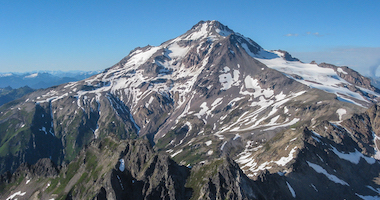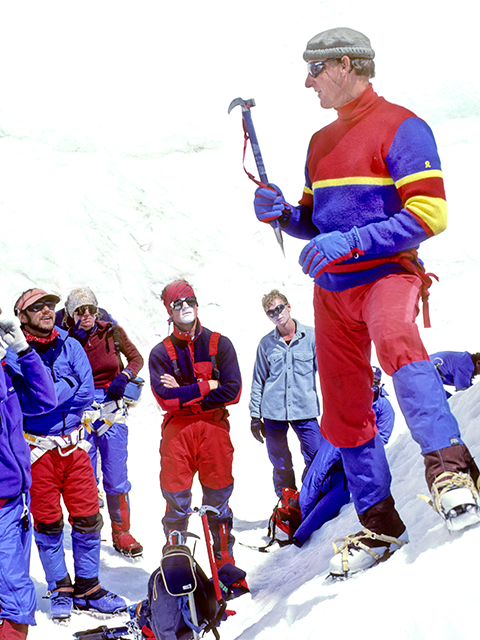Most Popular Entries
Tuesday, June 29, 2021 - 10:12 pm PT
The morning weather looked promising enough for early rising. We launched into breakfast and made the decision to take one last acclimatization day before moving up to 14 thousand feet. That meant that breakfast turned into brunch and that we would spend the day aggressively resting so as to be ready for a move tomorrow. It was generally fine weather down on our part of the mountain and we got in good naps and meals and snacking sessions. By afternoon and evening, clouds were stacking up on the mountains around us but things remained calm at 11,000 ft.
Best Regards,
RMI Guide Dave Hahn
Sunday, June 13, 2021 - 3:34 pm PT
Today we enjoyed a full rest day at Denali 14K Camp. Everyone is feeling nice and dried out and rested. The weather is gorgeous and is supposedly going to be nice for us to carry above the fixed lines tomorrow!
Stay tuned,
RMI Guides JT Schmitt, Alan Davis, Kiira Antenucci and the RMI team
Today we woke up with clear skies! After breakfast we shouldered our packs and went for a hike to the Southeast Fork of the
Kahiltna Glacier. The Fork offers spectacular views of the North Buttress of Mt. Hunter, South Face of Radio Tower, and the West Face of Kahiltna Queen. We also learned about snow anchors and glacier travel. It was really nice to be able to stretch our legs and hike around. It certainly was a fantastic day.
We also had the opportunity to eat dinner outside enjoying the incredible views. The weather is looking nice for the rest of the week, so we will be getting around.
Everyone is doing great!
RMI Guide Andres Marin
Wednesday, June 9, 2021 - 9:40 pm PT
We woke up hoping to cache below 14,000 Camp, the mountain had other plans so we spent the day eating, reading, relaxing, and building a snow fort. Hopefully tomorrow the weather complies and we can move supplies up the mountain.
RMI Guide Kiira Antenucci
Another day, another incredible Tanzanian National Park. Today we visited
Tarangire... A system of rivers, swamps and savannas that host a mind-blowing number of elephants, zebras, wildebeest, gazelles, giraffes and just about every other East African animal you can think of. We were particularly interested in the big cats today. As luck would have it, we spied a cheetah, a lioness up a tree, and finally a big and beautiful leopard in an Acacia tree at sunset. The elephants of Tarangire were everywhere and their signs of passage were everywhere else. We could see where they'd been scraping bark from the giant baobab trees in search of moisture, and flat out destroying smaller trees in other places. In terms of bird-life, we saw everything from an African Fish Eagle (eerily similar to an American Bald Eagle) to the ubiquitous superb starlings with their incandescent colors. It was just getting dark when Joseph and Clement brought our Landcruisers in to Kikoti, a hotel of screened in cabins with a luxurious and open-planned center dining room and bar just to one side of the national park. This will be our last evening together and our last out in the wild, but we look forward to a final day's journey back through the park and "home" to Arusha.
Best Regards,
RMI Guide Dave Hahn
As planned, today was our hiking and acclimatizing day at Namche. Since we are now well and truly "at altitude" it pays to go slowly. We'll actually spend three nights here at 11,200 feet before ratcheting up the sleeping altitude again. Light exercise on such days can enhance acclimatization, and so we went for a fine hike. First, we climbed straight up and out of Namche to reach Syangboche, at close to 12,000 ft, then we moved East to gain ridiculously good views of Ama Dablam, Lhotse and
Everest. Combined with the already insane vistas to our South and West of Thamserku and Quangde, respectively, it was nearly overwhelming... too much to fully take in. So we walked to the Everest View Hotel, sat on an open terrace and sipped hot lemon juice while pondering the view. It looked quite windy and nasty up high on Lhotse and Everest (Nobody tries to summit in March for good reason) but where we sat it was sunny and calm. We then walked over for lunch in the village of Khumjung and finally up to Khunde before crossing the forested ridge line once again for Namche.
It was a great stretch of the legs and lungs on uncrowded and garden-like trails. The afternoon back down in Namche then seemed just perfectly made for napping.
Best Regards,
RMI Guide
Dave Hahn & Team
Our first
Vinson climb of 2013 is not quite off the ground yet. The team successfully negotiated the airports of the world to assemble in Punta Arenas in the South end of Chile, and we've gone through several meetings, gear checks and briefings. We've shared a few great meals and some walks around town. We've packed our bags and weighed them and consigned them to our logistical partner in this endeavor, ALE, for loading onto the Ilyushin 76 jet transport. Normally, we'd be savoring a final night indoors before the journey to less comfortable regions of the Antarctic interior. But we've learned that stormy weather is hampering flight operations at Union Glacier. The needed supply flights are backed up a bit and we can't possibly get in within the next few days. We choose to greet this news in a positive light... It gives us the chance to be tourists in Patagonia for a few days. Stand by to see what we get up to.
Best Regards,
RMI Guide Dave Hahn
A restful rest day was had by all... Mostly. We slept late, until almost 9 in the morning, and then emerged to find the world a dozen shades of grey as multiple cloud layers shifted slowly about. Our chefs prepared a sumptuous breakfast of egg and bacon quesadillas and we sat about in down coats telling stories for a bit before returning to the comfort of the tents for the day, determined to catch up on sleep and hydration. Our weather forecast made it plain today that we could expect at least a couple days of snow and so it was decided to grab back two days of food from the cache we'd placed at 16,200' yesterday. Geoff and Zeb made the round trip in 2 hours and 15 minutes... just in time since shortly after their return it began to snow heavily. Continued snow will make the cache inaccessible for a time as we may need to let avalanche conditions settle. The team got out in the weather long enough to beef up the tent anchors and eat a hot dinner in the POSH dining tent. Despite the forecast and the snow, spirits remain high.
RMI Guide Dave Hahn
Greetings from beautiful Kahiltna Base Camp! Despite breezy conditions this morning the guys at K2 Aviation were able to get us on the glacier later this morning. We spent the rest of the afternoon setting up a simple camp and getting everything ready to head out on the route early tomorrow morning. The views on the flight in were spectacular as always but this time especially so because there wasn't a cloud in the sky. The team has been hanging out and soaking in the immensity of our new environs. We'll check in tomorrow from our next camp around 7,800' or so.
Ciao for now,
RMI Guide Billy Nugent
On The Map
Tuesday, July 9, 2019 - 1:11 AM PT
The longest day. The weather remained stable and perfect... to a scary extent. Some of us lay awake last night at 14,000 just listening to the violent detonations of rock hitting ice and snow at terminal velocity. The high temps were to blame and those high temperatures were part and parcel of the prolonged good weather that allowed us to summit. For those monitoring the rockfall, it was a relief that wake-up time was at 11 PM. Best to be up and busy eating and packing then to be hearing rock and imagining worst case scenarios for a team passing Windy Corner ridiculously close up under the cliffs. We were walking at 12:30 AM and soon got to see the battlefields where car-sized chunks of granite had left deep tracks and impact craters on either side of the “trail”. Sure enough, in the zone where rockfall danger demanded our fullest attention, the track began to go over crevasse after crevasse and crappy bridge after crappy bridge. We struggled (as every one does) the then, surprisingly, the route got better. We were pleased to find things frozen up and easy travel far below the point where we’d been told to expect freezing.
Once at 11,000' the nature of travel changed. We traded crampons for snowshoes and ice axes for ski poles. The morning/evening light was brilliant on Denali. Conditions on the lower glacier were way better than we expected. We just kept trudging as the light changed and found ourselves walking up Heartbreak Hill starting at 9:30 AM. It was 11:30 before we were at the “upper strip” on the SE Fork with all of our Basecamp caches relocated from the lower strip. Our pickup arrived just after 3 PM. We loaded and lifted off and flew into smoke as the pilots pointed their Otters toward Talkeetna. We got out of the planes in down jackets... immediately appreciating that the ambient temp at TKA was over 90 degrees F. Afternoon was then spent drying gear and reconnecting to the world. We met for a celebratory dinner at the West Rib and discussed our good fortune. Day 19 was a long one, but also a very good one.
Best Regards
RMI Guide Dave Hahn
Previous Page
Next Page
.jpg)

























GO TEAM DAVE . Sending Prayers & Best to Ur team ... Take care y’all & Keep smiling !!! Please give our luv to Sanjeev Nagrath —- Rohan, Courtney, Nora , Niki & Anjalika
Happy Day :)
Posted by: Anjalika Nagrath on 7/1/2021 at 8:14 am
View All Comments